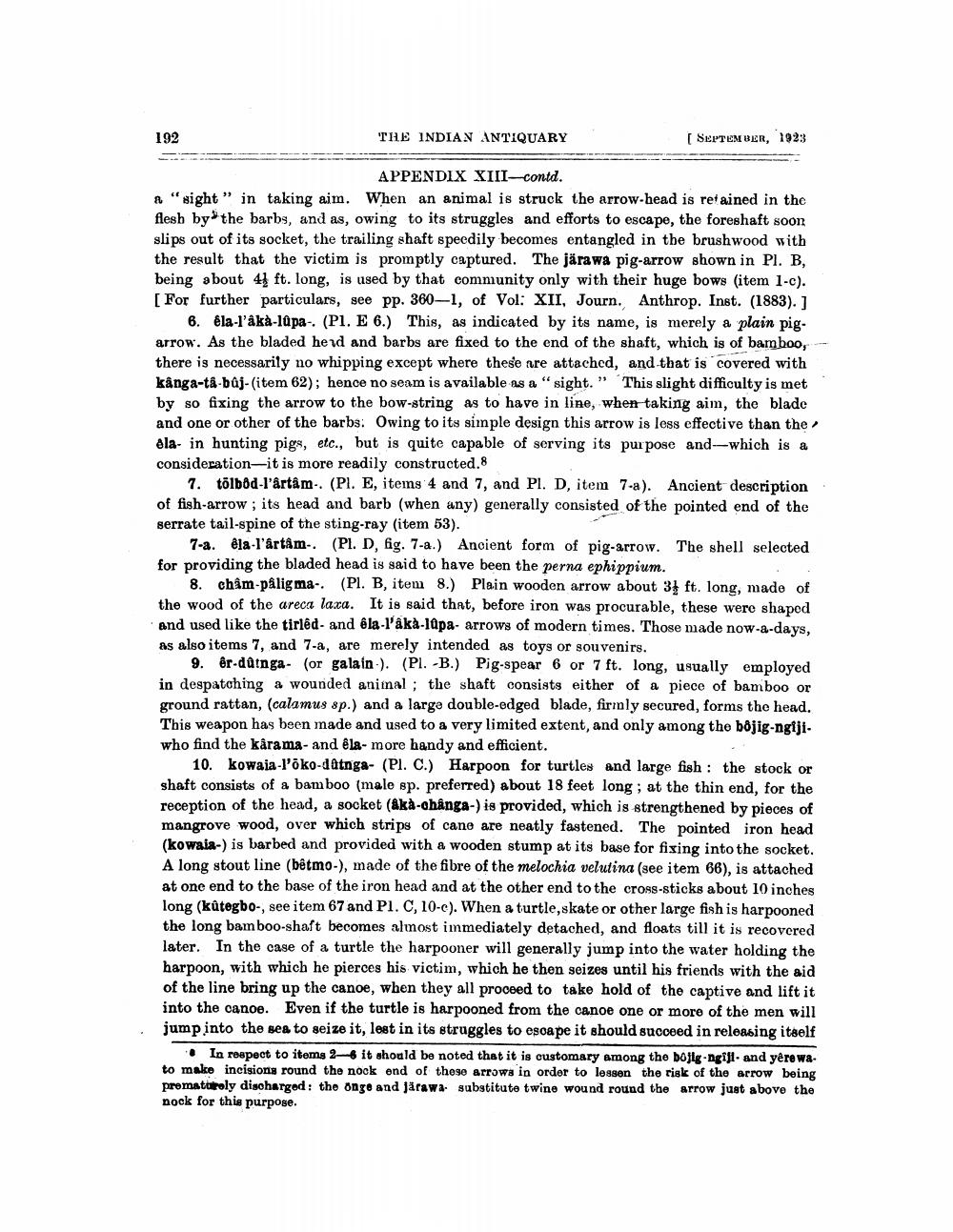________________
192
THE INDIAN ANTIQUARY
[ SEPTEMBER, 1923
APPENDIX XIII-contd. "sight” in taking aim. When an animal is struck the arrow-head is retained in the flesh by the barbs, and as, owing to its struggles and efforts to escape, the foreshaft soon slips out of its socket, the trailing shaft speedily becomes entangled in the brushwood with the result that the victim is promptly captured. The järawa pig-arrow shown in Pl. B, being about 41 ft. long, is used by that community only with their huge bows (item 1-c). [For further particulars, see pp. 360-1, of Vol: XII, Journ. Anthrop. Inst. (1883). ]
6. éla-l'âka-lupa. (P1. E 6.) This, as indicated by its name, is merely a plain pig. arrow. As the bladed hed and barbs are fixed to the end of the shaft, which is of bamboo, there is necessarily no whipping except where these are attached, and that is covered with kânga-tå-baj-(item 62); hence no seam is available as a "sight." This slight difficulty is met by so fixing the arrow to the bow-string as to have in line, when taking aim, the blade and one or other of the barbs: Owing to its simple design this arrow is less effective than the ala- in hunting pigs, etc., but is quite capable of serving its purpose and-which is a consideration-it is more readily constructed.8
7. tölbod-l'ârtâm.. (Pl. E, items 4 and 7, and PI. D, item 7-a). Ancient description of fish-arrow; its head and barb (when any) generally consisted of the pointed end of the serrate tail-spine of the sting-ray (item 53).
7-. @la-l'ârtâm.. (Pl. D, fig. 7-a.) Ancient form of pig-arrow. The shell selected for providing the bladed head is said to have been the perna ephippium.
8. chîm-pålig ma-. (Pl. B, item 8.) Plain wooden arrow about 34 ft. long, made of the wood of the areca laxa. It is said that, before iron was procurable, these were shapod and used like the tirled- and @la-l'aka-idpa-arrows of modern times. Those made now-a-days, as also items 7, and 7-a, are merely intended as toys or souvenirs.
9. @r-danga- (or galain). (Pl.-B.) Pig-spear 6 or 7 ft. long, usually employed in despatching a wounded animal; the shaft consists either of a piece of bamboo or ground rattan, (calamus sp.) and a large double-edged blade, firmly secured, forms the head. This weapon has been made and used to a very limited extent, and only among the bôjig-ngiji. who find the karama- and êla-more handy and efficient.
10. kowaia-l'oko-datnga- (PI. C.) Harpoon for turtles and large fish: the stock or shaft consists of a bamboo (male sp. preferred) about 18 feet long; at the thin end, for the reception of the head, a socket (aka-changa-) is provided, which is strengthened by pieces of mangrove wood, over which strips of cane are neatly fastened. The pointed iron head (kowaia-) is barbed and provided with a wooden stump at its base for fixing into the socket. A long stout line (betmo.), made of the fibre of the melochia velutina (see item 66), is attached at one end to the base of the iron head and at the other end to the cross-sticks about 10 inches long (kûtegbo-, see item 67 and Pl. C, 10-c). When a turtle,skate or other large fish is harpooned the long bamboo-shaft becomes almost immediately detached, and floats till it is recovered later. In the case of a turtle the harpooner will generally jump into the water holding the harpoon, with which he pierces his victim, which he then seizes until his friends with the aid of the line bring up the canoe, when they all proceed to take hold of the captive and lift it into the canoe. Even if the turtle is harpooned from the canoe one or more of the men will jump into the sea to seize it, lest in its struggles to escape it should succeed in releasing itself
In respect to items 2-it should be noted that it is customary among the bojlg ngiji. and yere wa. to make incisions round the nook ond of these arrows in order to lessen the risk of the arrow being prematuroly discharged: the ongo and Järawa substitute twine wound round the arrow just above the nock for this purpose.




